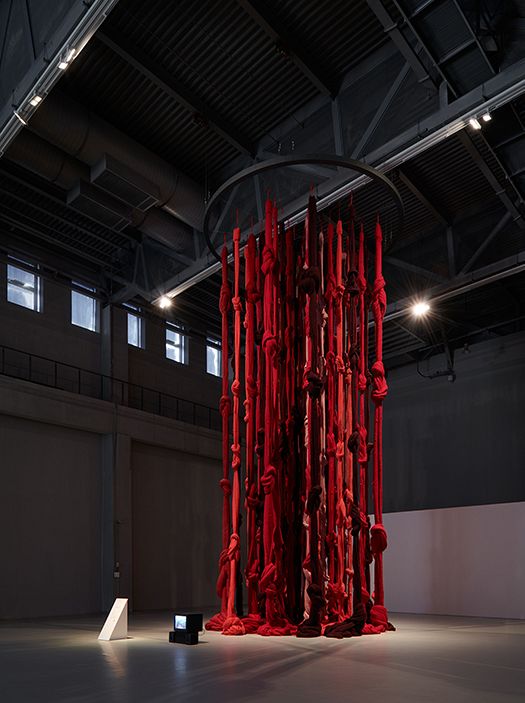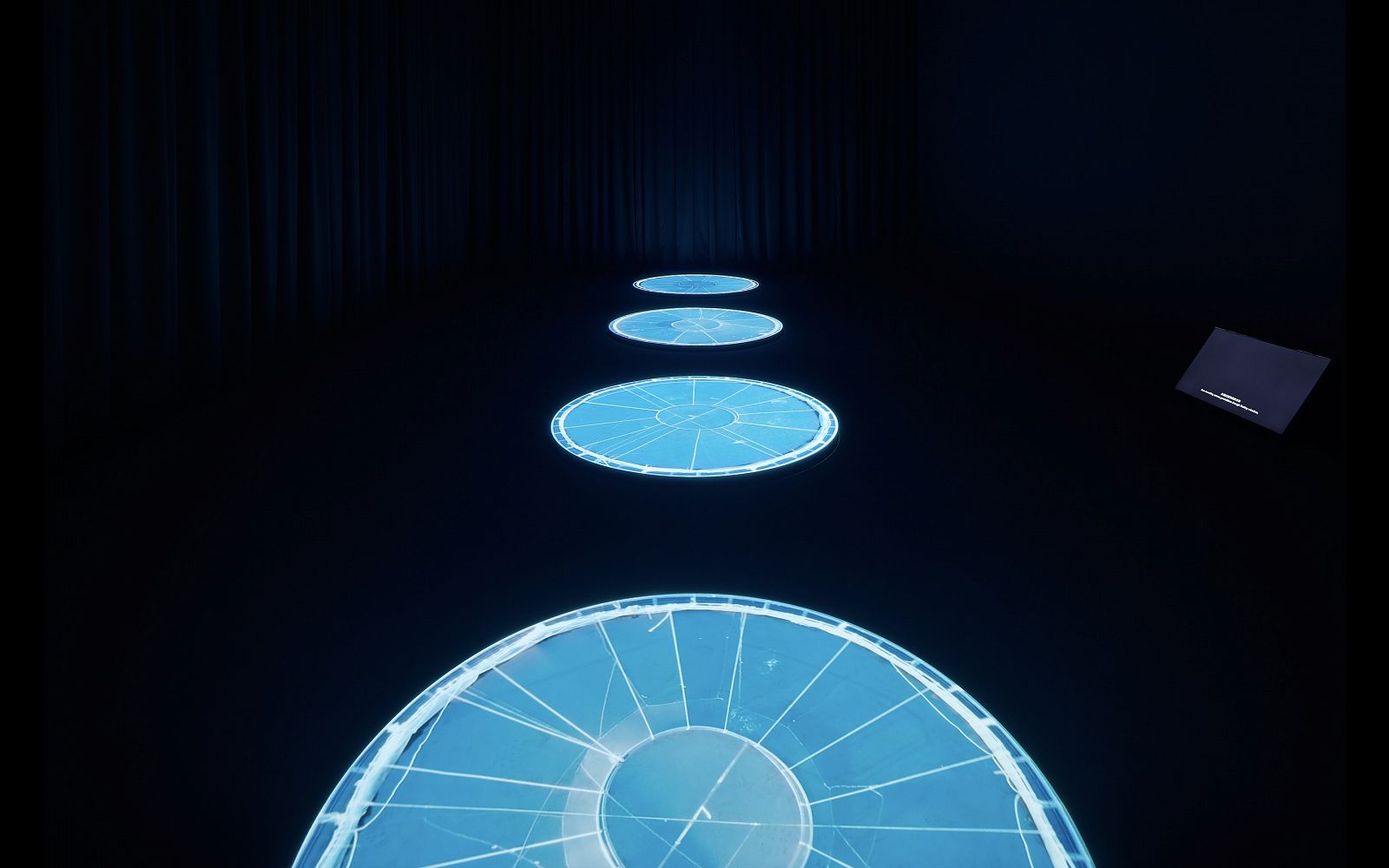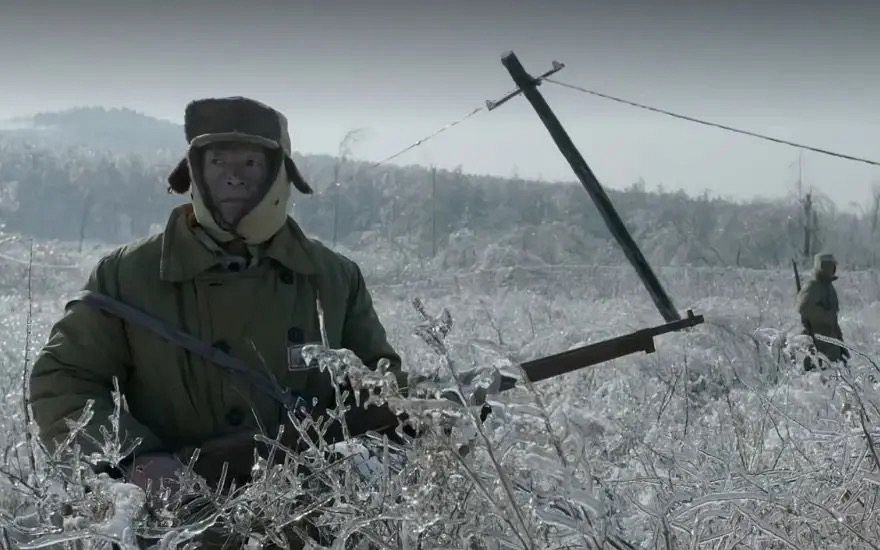Most people might be tempted to roll their eyes at the old quip about butterflies stirring up hurricanes across the country—but what better way to explain why, because a woman asked someone to stop smoking, an entire biennale was scrubbed of the Chinese characters for “menstruation”?
The woman, of course, is Xiao Meili, whose desire not to inhale secondhand smoke somehow escalated into a Weibo flamewar between genders, and earned her the indictment, by furious netizens, of being an agent of the CIA or LGBTQ (one of which is a nefarious, all-powerful organization bent on regime change—and the other headquartered in Langley, Virginia).
As for the biennale, it was none other than Shanghai’s, and the sole reason I know about the missing words is that they have only gone missing from Chinese foreword, not the English: “All bodies are wet collective bodies, defined by how they link to other bodies, places, environments, technologies. Think of breathing, crying, ejaculating, fertilizing, flushing, kissing, menstruating, salivating, sweating, transfusing” [emphasis mine].
So much for the chief curator Andrés Jaque’s’s exuberant declaration, borrowing from new materialist philosopher Astrida Neimanis, that we are all imbricated in a “planetary wet-togetherness, a ‘commoning’ force that constitutes all bodies as collective hydro-subjects”! How rich to affirm togetherness while being forced to institute linguistic separatism in an exhibition. The average monolingual Chinese viewer won’t even realize what has happened (neither, I suspect, will the average anglophone viewer).
Consequently, all the feminist artworks in the exhibition have become collateral damage. Most unfortunate is Cecilia Vicuña’s Quipu Menstrual (“Menstrual Khipu”), a monumental installation in which bright red wool hangs from the ceiling, an obvious metaphor for the female body function on which Neimanis’s argument partly depends (though to a much smaller degree than lactation)—domesticated into the nonsensical Chinese 奇普纪事 (“Record of Khipu”).
Of course, to proceed down this line of complaint is to invite a certain impatient rebuke—that I am yet another Westerner relying on anti-censorship critique (hardly original or exacting) as a crutch for my cultural illiteracy. Like one of Lacan’s non-dupes, I have failed to realize that the hidden order I am supposedly exposing is either so banal and obvious that I shouldn’t even bother, or too crushingly powerful to ever change. Why not, my critics might ask, bring the instruments of close reading to the actual content of the show?
But I did exactly this, wandering around the Power Station of Art and the Sunke Villa, home of another branch of the exhibition—and the verdict I reached, unfortunately, was that the good artworks in the Bienniale (and there were good artworks) were cheapened by the curatorial framework, which would be aesthetically empty and ethically spineless even if its Chinese text had not been tampered with.
Let me be clear: it is imperative to create new political imaginaries in an age where Amitav Ghosh points out “most forms of art and literature [are] drawn into the modes of concealment that prevented people from recognising the realities of their plight.” It is urgent to make the unthinkable—climate catastrophe—thinkable, and to expand this little, provincial tribe—homo sapiens—into a vaster republic of animals and things. The problem is that Astrida Neimanis fails to accomplish any of these lofty goals.
Methodologically, Neimanis’s essay “On How to Become a Body of Water” and her monograph Bodies of Water are a mess, engaging in anti-positivist oceanic poetics (“this watery body also escapes and repeats differently…becoming something else: human body becoming weather current, becoming whale body…”) in one breath, then beating us over the head with lame, pop science facts in another (“sixty to ninety percent of your bodily matter is composed of water”) without ever really justifying the transition. The deeper problem, however, is that of first principles: Neimanis’s central concept that we are all “bodies of water” is trivially, tautologically true, like the statement that grass is green. Just replace the “hydro” in “hydrofeminism” with “aero” or “nitro,” and see how little the idea suffers—which is to say, how little it said in the first place.
Even worse, these stunningly obvious statements provide cover for new materialism’s race-blind excesses, a critique that has been leveled at far more rigorous “posthumanist” thought, including that of Donna Haraway, an obvious influence on Neimanis. The author of Bodies of Water is eager to demonstrate her familiarity with Black scholars, like Fanon and Morrison and Lorde. But no sooner does she celebrate what they “have taught us about difference” that such difference again becomes fodder for a mind-numbing universalism: “We are all bodies of water, with pumped-up vulnerabilities, leaking, sponging, sloshing, dripping, sipping.” Is it any wonder that, in an interview for Mousse magazine, Neimanis ignores point-blank a question about Black Lives Matter, instead defaulting to a general statement about the importance of “activism”?
What new communities does this “wet-togetherness”—which might serve better as the title of a retro porn flick—actually forge? How would a Lakota water defender, risking life and limb to stop the construction of the Dakota Access Pipeline, benefit from such a concept? Faced with the concussion grenades and batons of National Guardsmen, would she shout, Stop! We’re all bodies of water! How would residents of Uttar Pradesh, forced to bury family members stricken down by COVID, react to some platitude about the river Ganges and togetherness? Hasn’t COVID-19, of all things, shown the world how ontological bonds—we could all die of coronavirus—are distributed differentially among lines of race and gender and class and age and nationality?
In the face of this sort of critique, Neimanis begins to flip-flop: “As bodies of water, ‘we’ are all in this together…but ‘we’ are not all the same, nor are we all ‘in this’ in the same way.” What a stupendously obvious thing to say! “All grass is green, but it’s not all the same shape or size!”
What can such a race-blind philosophy offer us when viewing the Bienniale’s standout artworks, like Royce Ng and anthropologist Daisy Bisenieks’s A Season in Shell? Certainly, its documentation of the passage of abalone from the hands of Somali fishermen to Hong Kong seafood markets is on-brand for new materialist storytelling—but for the bitter Ugandan businessman at its center, it is hardly commonalities, but differences, that undermine Belt and Road propaganda. “These monkeys, these racists,” he says to the artists, after being refused the right to open a bank account. “They take one look at my face and shake their heads… I want you both to come with me… You have the face of a local and you are a white woman, they cannot refuse you as they’ve refused me.” (The one false note in the piece is its claim that “in his home country of Uganda there are no addresses”1In fact, Uganda does have addresses but does not have postal code system —surprising, given that one of the authors is an academic).
How can Neimanis’s nigh ahistorical universalism help us understand Wang Tuo’s Tungus? True, the film’s protagonists, two Korean volunteers to the Communist siege of Changchun, have deserted for Jeju, whose waters are an integral symbol in Korean shamanism. But Wang’s real concern lies with the ironies and uncertainties of historical reconstruction: one of the volunteers provides a corrupted retelling of Tao Yuanming’s Peach Blossom Spring, in which the inhabitants of the Spring wear Wei and Jin attire—clearly impossible, if they fled centuries before. All attempts at finding an Archimedean point from which to understand history fail, and the soldiers soon find themselves walking in circles. (The problem with the “Dongbei Tetralogy,” I am told, is that its allusions and classical Chinese tend to sound a bit hackneyed—but I have my middle-school Chinese to thank for not noticing.)
If I am very charitable, the sole artwork that seemed to jive well with Astrida Neimanis’s thought is the collective Cooking Section’s Salmon: A Red Herring, a sound installation exploring how the human consumption of salmon has caused Lamarckian evolution: farmed fish escape into the wild and mate with others of their species, passing on diseases that will cause such a degree of mutation as to transform the victim into a different species. This dovetails nicely with Neimanis’s assertion that all watery bodies are “carrier bags,” connecting with each other “in diverse exchanges, gifts, thefts, and forsakings.” But Salmon succeeds because its scope is modest: it does not lay claim to the ocean, but rather an aquarium-sized bit of territory.
More often, Neimanis sounds like one of the insufferable white feminists from whom she is trying to distance herself, channeling a kind of faux spirituality best captured by Ayesha Tan Jones’ cringeworthy Dream After Screen. In this high-concept Choose Your Own Adventure game, viewers are able to choose between branching paths (each a different video) by touching different piles of dirt next to the monitors, thereby helping Jones’s alter ego, Una Jynxx, escape the labyrinth of reincarnation. Pick wrong, and you get a “game over screen”—Jynxx is forced into another “life.” Watching a clip of Una Jynxx, sitting cross-legged and crusty, I was reminded of nothing so much as Western tourists traveling in India for their gap year. Here, too, the artist’s universalizing platitudes are undercut by the work’s linguistic separatism: whichever staff member translated the subtitles forgot the line “You know, all the lives that I’ve lived,” which simply reads: “ADD CHINESE HERE.”
I do not want to be mean-spirited. The curatorial team for the Shanghai Bienniale should be applauded for soldiering on in the face of official philistinism, and for working under less-than-ideal circumstances to bring a huge slate of events to fruition. Curatorial texts are meant to be springboards for thought, not manifestoes—plenty of questionable concepts could prove fruitful exhibition titles. But in cleaving so faithfully to Neimanis’s vision, Jaque ends up sinking with it, like a captain in his ship.
Close reading done, I want to return to the dismissal of my original complaint: that the order of things is so obvious or so monstrously complex that it isn’t worth bringing up. It is true, of course, that the local realities of post-socialist China are often obscured by Orientalist visions and Cold War biases. Even for locals, the system often proves too devilishly large to conceptualize; nor do critics in other parts of the world fare better. Such causal overdetermination—identified by Louis Althusser, expanded upon by Frederic Jameson—is now considered a cornerstone of the aesthetic movement called Postmodernism.
Revital Cohen and Tuur Van Balen’s The Odds shares this Postmodernist sensibility. The film cuts between scenes of anesthetized racehorses, hauled away by their trussed-up hooves by machines, and showgirls dancing in a casino, their spangled, high-heeled feet describing intricate patterns on the stage. All the while, a perfume synthesized from dead horse arum lily—which imitates decomposing matter in order to attract flies—wafts through the space. Tellingly, the artwork description informs viewers who try too hard to penetrate its surface and discover some deep, abiding meaning that they are suffering from “apophenia, a psychiatric term describing the tendency to perceive meaningful connections between unrelated things.” This could just as easily have come from the blurb of one of Thomas Pynchon’s novels.
But postmodernism’s pitfall, as David Graeber reminds us, is that its “celebration of the endless play of images and surfaces,” is, in fact, merely “a desperate way to take what could otherwise only be felt as a bitter disappointment and to dress it up as something epochal.” My point is not to express distaste at Cohen and Van Balen’s aesthetic—The Odds was easily my favorite film in the entire biennial—but rather to question the hermeneutic pessimism they use to shut down progressive readings of it.
Why not instead try and point out the naked and unpleasant truth? The high-heeled feet of the showgirls, I think, bear a striking, morphological similarity to those of the racehorses—one missed step, and either might be put to pasture or put down. And even then, the system won’t be done with them. Their bodies—our bodies—will be distilled into a sweet, stinking perfume. This much ought to be obvious to anyone that looks. Even if the creators themselves tell us we’re crazy.
Henry Zhang is a writer and translator living in Beijing.


